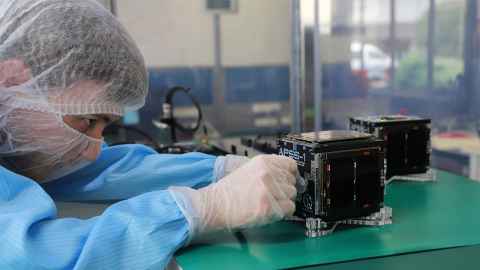New Zealand’s first student-built satellite ready for lift off
3 November 2020
New Zealand’s first satellite designed and built by university students is about to be launched into space via Rocket Lab’s Electron launch vehicle.

University of Auckland students conceived, designed and built the satellite which they have named Te Waka Āmiorangi o Aotearoa (the New Zealand satellite vessel) APSS-1. It will be lofted to sun-synchronous orbit at 500 km altitude as one of 30 satellites aboard Rocket Lab’s 16th Electron launch this month. The launch will take place from Rocket Lab’s launch site on the Māhia Peninsula.
It’s been a three-and-a-half-year journey that has seen more than 26 students contribute to the project.
“I never really thought I could be a part of something that involved space, I thought it was something other people did,” says Bachelor of Engineering graduate Francis Moynihan Lavey.
“A lot of hard work went into this project and at times it was stressful. Looking back, I feel a sense of relief and liberation that we’ve reached the goal.”
The satellite the students designed will measure electrical activity in the upper reaches of Earth’s atmosphere right at the edge of space, a region known as the ionosphere. Because the ionosphere is ionised by solar and cosmic radiation and is affected by phenomena such as solar winds, it is uniquely reactive to changing magnetic and electrical conditions. That means it affects radio and GPS signals here on Earth including television, internet and telephone communications.
But scientists are also curious to what extent and how the ionosphere is affected by geophysical activity on Earth, including whether the electrical disturbances that occur in the ionosphere might be correlated with earthquakes. Insights into the ionosphere might also help us better prepare for disruption to communications technologies.
Te Waka Āmiorangi o Aotearoa is part of a Rocket Lab ‘rideshare’ where each satellite can be deployed to a unique orbit via Rocket Lab’s Kick Stage. This means once the Electron launch vehicle’s second stage reaches orbit, the Kick Stage separates and takes over as a space ‘tug’ for the final leg of the journey, providing propulsion and pointing to deliver multiple satellites to precise, individual orbits.
“The APSS-1 mission is a triumph for the students and faculty at the University of Auckland and a significant step for the New Zealand space industry overall,” says Rocket Lab founder and CEO, Peter Beck.
“Less than four years ago we didn’t have domestic space launch capability and now, we’re launching New Zealand’s first student-built satellite from kiwi soil. It marks the beginning of a whole new era of space research, development, and opportunity for local students.”
The APSS-1 project was multi-disciplinary, encouraging undergraduates across different faculties – including Engineering, Science and Business and Arts – to work together to come up with the concept for a satellite. Participants have gone on to work in the aerospace industry both in New Zealand and overseas including at NASA.
“The project is really an exciting story about students having the opportunity to do something extraordinary and stretch their imagination beyond the edges of our planet, readying them for the challenges of the future,” says Faculty of Engineering director of Auckland Programme for Space Systems, Jim Hefkey.
To support New Zealand’s next generation of space industry leaders, Rocket Lab is providing the launch service for APSS-1 to the Auckland Programme for Space Systems at no cost.
The Auckland Programme for Space Systems is supported by US-based engineering alumnus Neil Paton and his wife Louise. Their philanthropic support has been fundamental to allowing delivery of the programme and in supporting the students to design, develop and ultimately launch the satellite.
Media contact
Aroha Mane | Media adviser
Mob 021 244 9707
Email aroha.mane@auckland.ac.nz